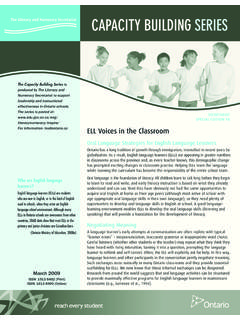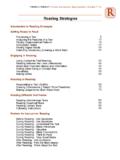Transcription of Caring and Safe Schools in Ontario - edu.gov.on.ca
1 Caring and Safe Schools in Ontario Supporting Students with Special Education Needs Through Progressive Discipline, Kindergarten to Grade 12. Contents 1. Introduction 3. The Purpose of This Resource Document 3. Ministry Initiatives 5. Ontario School Board Initiatives 7. Initiatives in Other Jurisdictions 7. Framework for Promoting Positive Student Behaviour 7. Preview of the Rest of This Document 9. 2. Promoting Positive Behaviour Through a Caring and Safe School Culture 10. Guiding Principles 10. A Caring and Safe School Culture What Does It Look Like? 11. The Influence of School Culture on Student Learning and Behaviour 12. Assessing School Culture 13. Building a Caring and Safe School Culture 16. Steps in Implementation 16. Roles and Responsibilities in Implementation 18. 3. Understanding Student Behaviour 20. What Do You Need to Know? 20. Specific Conditions Affecting Behaviour 22.
2 Communication Disorders 23. Executive Function Deficits 25. Mental Health Problems 27 Additional Factors Affecting Behaviour 29. Assessing Capacity in the School, Home, and Community 32. Areas of Knowledge: A Summary 32. 4. Investigating Strategies, Tools, and Resources 34. Strategies to Promote Positive Behaviour 34. Direct Teaching of Social Skills 34. Character Development Programs 35. Une publication quivalente est disponible en fran ais sous le titre suivant : Bienveillance et s curit dans les coles de l' Ontario : La discipline progressive l'appui des l ves ayant des besoins particuliers, de la maternelle la 12 e ann e. This publication is available on the Ministry of Education's website, at Strategies to Address Inappropriate Behaviour 35. A Problem-Solving Approach 35. Restorative Practices 36. Assessment and Planning Tools 37. Early Development Instrument 37.
3 Functional Behaviour Assessment 38. Risk Assessment 38. Behaviour Support Plan 39. Safety Plan 39. Instructional Strategies 40. Cooperative Learning 40. Differentiated Instruction 40. The Tiered Approach 40. Universal Design for Learning 40. Strategies and Tools for Specific Purposes: An Overview 41. Internal and External Resources 43. Print and Internet Resources 44. Bullying and Bullying Prevention 44. Communication and Communication Disorders 44. Executive Function Deficits 45. Mental Health Problems/Mental Illness 46. Websites 46. 5. Addressing Behavioural Issues Through a Progressive Discipline Approach 47. Assessing Student Behaviour 48. Considering Mitigating Circumstances and Other Factors 50. Taking Action 54. Appendix: Sample Planning Template 56. Glossary 57. References 60. 1 Introduction The Purpose of This Resource Document T. he Ontario Ministry of Education recognizes that all students require a Caring and safe environment and individualized support in order to learn, develop their potential, and stay in school.
4 Over the years, the ministry has taken a number of initiatives to assist Schools in meeting these requirements. The present document is intended to serve as a practical resource for superintendents, principals, and vice-principals, to help them address issues of student behaviour both through instruction and interventions tailored to individual student needs and through ongoing efforts to build and maintain a Caring and safe school culture. The document sets out a framework that system and school leaders may use to strengthen Schools ' ability to provide a Caring and safe environment, in which responses to behaviour issues are shaped by informed consideration of students'. needs and circumstances. While the ideas and strategies outlined here are appro . priate for use with all students, the focus of this document is on the particular circumstances of students with special education needs.
5 More specifically, this resource document is intended to: assist system and school leaders to promote and support a Caring and safe school culture;. provide information about appropriate strategies and resources to help system and school leaders address behavioural challenges for students, in particular students with special education needs. 3. There is a direct link between success in school and the school environment in which student learning takes place. Students are more motivated to do well and achieve their full potential in Schools that have a positive school culture and one in which they feel safe and supported. (Safe Schools Action Team, 2008, p. 1). The investigations of the Safe Schools Action Team have confirmed that a safe and supportive environment for learning and working is one of the most important factors that influence the quality of student learning and achievement (Safe Schools Action Team, 2008).
6 Students who experience a positive school culture feel supported and accepted by peers and school staff and tend to develop a strong sense of school membership. Feelings of belonging enhance students' self-esteem and can contribute both directly and indirectly to improvements in academic and behavioural functioning and overall mental health. Students who feel accepted are more likely to develop strong literacy skills and make a positive contribution to the school culture and are less likely to commit infractions. Conversely, a low sense of school engagement in students appears to be correlated to a higher incidence of emotional and beha . vioural disorders (Canadian Public Health Association, 2003). This suggests that an approach to dealing with inappropriate student behaviour which enables students to feel supported and accepted at school may contribute to improved student learning and behaviour and help students stay in school.
7 Promoting positive behaviour through a Caring and safe learning environment and an individualized approach to behaviour issues begins with system and school leaders, who set the tone for the system and Schools . They bear the primary respon . sibility for working with teachers and other partners to create an environment in which individual students and adults are treated fairly, equitably, and with dignity and respect. It is hoped that the ideas in this document will be helpful to them . and also to all staff, including special education resource teachers, to parents, and to other stakeholders. Caring and Safe Schools Leading Schools as in any great organization requires principals with the courage and capacity to build new cultures based on trusting relationships and a culture of disciplined inquiry and action. (Fullan, 2003). 4. Ministry Initiatives n The Ministry of Education has undertaken a number of initiatives to help Schools build a culture of Caring and address issues of safety and inappropriate behaviour in Schools .
8 In December 2004, the ministry established the Safe Schools Action Team and invested in a comprehensive, province-wide, bullying-prevention strategy. After widespread public consultation, the Safe Schools Action Team released Shaping Safer Schools : A Bullying Prevention Action Plan in November 2005 and Safe Schools Policy and Practice: An Agenda for Action in June 2006. These two reports identified priorities for action and made recommendations to the ministry and school boards with respect to bullying prevention, progressive discipline, com- munity and parental involvement, application of the Safe Schools Act, programs for suspended/expelled students, education and training, communication, and a Provincial Safe Schools Framework. In addition, in December 2008, the Safe Schools Action Team released a further report Shaping a Culture of Respect in Our Schools : Promoting Safe and Healthy Relationships calling for action to address serious issues such as gender-based violence, homophobia, sexual harassment, and inappropriate sexual behaviour between students in Schools .
9 The ministry itself consulted extensively on the safe Schools provisions of the Education Act in order to develop legislative amendments and related policies and regulations that would address the questions of school safety and of how to respond constructively to challenging behaviour by students. The amendments that came into force on February 1, 2008, mandated a progressive discipline approach for addressing inappropriate behaviour, to enable Schools to provide appropriate disci . pline while also ensuring that students have adequate opportunities to continue their education. These amendments also mandated the provision of professional supports, programming supports, and training for teachers and principals. Addi . tional amendments, which came into force on February 1, 2010, ensure that all serious incidents that occur at school are reported to the principal, that parents of victims are made aware of such incidents, and that staff who work directly with students respond to incidents when they occur.
10 (See Appendix 1 of Policy/Program Memorandum No. 145, Progressive Discipline and Promoting Positive Student Behaviour [October 19, 2009].). The term progressive discipline , as defined in PPM No. 145, refers to a whole- school approach that utilizes a continuum of prevention programs, interventions, supports, and consequences to address inappropriate student beha viour and to build upon strategies that promote and foster positive behaviours. Specifically, this Introduction means that When inappropriate behaviour occurs, disciplinary measures should be applied within a framework that shifts the focus from one that is solely punitive to one that is both corrective and supportive. Schools should utilize a range of interventions, supports, and consequences that are developmentally appropriate 5. and include learning opportunities for reinforcing positive behaviour while helping students to make good choices ( Ontario Ministry of Education, 2009g, p.)











